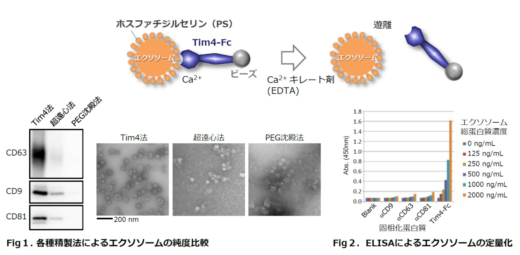Powerful tools offer unique insights into the functions of exosomes
Visualizing the dynamics of exosomes at the single particle level using scanning ion conductance microscopy live imaging

Rikinari Hanayama, Professor, Nano Life Science Institute (WPI-NanoLSI), Kanazawa University
Fascinating world of exosomes and their functions
“My research centers on clarifying the functions of exosomes in the human body,” says Hanayama. “Exosomes are 30 to 100 nm sized vesicles that are secreted by many cells. They are messengers of inter-cellular communications networks and we have discovered that the molecules on exosomes are useful as biomarkers.”
Examples of molecules on exosomes include those related to immune suppression and activation, disease proteins, and tumor progression. So exosomes play a major role in cell functions.
Hanayama has observed that exosomes express an anionic phospholipid phosphatidylserine on their surface, which is recognized by MFGE8 and Tim4—phosphatidylserine receptors. But no one has directly visualized what happens next to these exosomes. “Therefore, we believe Bio-SPM technology could give direct insights into the dynamics of individual exosomes,” says Hanayama. “We are using the powerful tool of Tim4 to analyze exosomes.”
Capturing and manipulating high purity exosomes
Hanayama has developed a procedure to capture exosomes using Tim4 via a calcium mediated interaction between Tim4 and phosphatidylserine on the surface of exosomes (Figure 1). Notably, intact exosomes are then isolated from Tim4 by adding calcium chelators such as EDTA. “Our isolation procedure is now available as a kit from FUJIFILM Wako Chemicals,” explains Hanayama. “It’s becoming a standard procedure in Japan.”
This method yields high purity exosomes, thereby enabling the identification of proteins and RNAs on exosomes that cannot be identified using conventional methods [1]. Also, the sensitivity of ELISA assays based on Tim4 for the detection of exosomes is about 1000 times greater than conventional methods (Figure 2).
BioSPM for visualizing the dynamics of exosomes at the single particle level
Hanayama is collaborating with experts on Bio-SPM both at the WPI and in England. “Optical microscopes only enable imaging of accumulations of exosomes,” says Hanayama. “We cannot see individual exosomes optically. So we are developing scanning ion conductance microscopy (SICM) for living imaging.
“As a first step, I used Tim4 to capture exosomes and succeeded in label free imaging of exosomes on the cell surface by SICM,” says Hanayama. “The research has just started and our next step is to visualize the dynamics of exosomes at the single particle level by using SICM live imaging.”
Research highlights
A selection of notable publications is “A novel affinity-based method for the isolation of highly purified extracellular vesicles”, Sci Rep [1] and “High purity isolation and sensitive quantification of extracellular vesicles using affinity to TIM4”, Curr Protoc Cell Biol [2].
References
- W. Nakai et al, “A novel affinity-based method for the isolation of highly purified extracellular vesicles”, Sci Rep. 6:33935 (2016). doi: 10.1038/srep33935.
- T. Yoshida et al, “High purity isolation and sensitive quantification of extracellular vesicles using affinity to TIM4”, Curr Protoc Cell Biol. 77:3.45.1-18 (2017). doi: 10.1002/cpcb.32.


